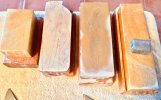Hi world,
I’m still building my kitchen knife sharpening skills and knowledge.
In the interim I’m using synthetic stones for my Stainless steel, VG-10, White #2 and AS stainless cladded knives.
Synthetic stone ranges I have are 220,800,1000,3000 and 6000 King and Suehiro.
Also using a flattening stone regularly (light touch after each session), and stroping for the last honing stage. I’m quite satisfied with the results but this is subjective of course.
Starting to look into the natural stones domain and the feedback I’m seeing as well as pricing points (!!) are intriguing.
Why are natural stones considered so much better for sharpening? What are the fundamental properties that makes a natural stone at estimated grit 6000-8000 so much better than an equivalent Suehiro, King or Naniwa?
And then for the return on investment aspect, would a x10 priced natural stone or even just x2 give similar performance ratio?
Thanks!
Saul
I’m still building my kitchen knife sharpening skills and knowledge.
In the interim I’m using synthetic stones for my Stainless steel, VG-10, White #2 and AS stainless cladded knives.
Synthetic stone ranges I have are 220,800,1000,3000 and 6000 King and Suehiro.
Also using a flattening stone regularly (light touch after each session), and stroping for the last honing stage. I’m quite satisfied with the results but this is subjective of course.
Starting to look into the natural stones domain and the feedback I’m seeing as well as pricing points (!!) are intriguing.
Why are natural stones considered so much better for sharpening? What are the fundamental properties that makes a natural stone at estimated grit 6000-8000 so much better than an equivalent Suehiro, King or Naniwa?
And then for the return on investment aspect, would a x10 priced natural stone or even just x2 give similar performance ratio?
Thanks!
Saul

